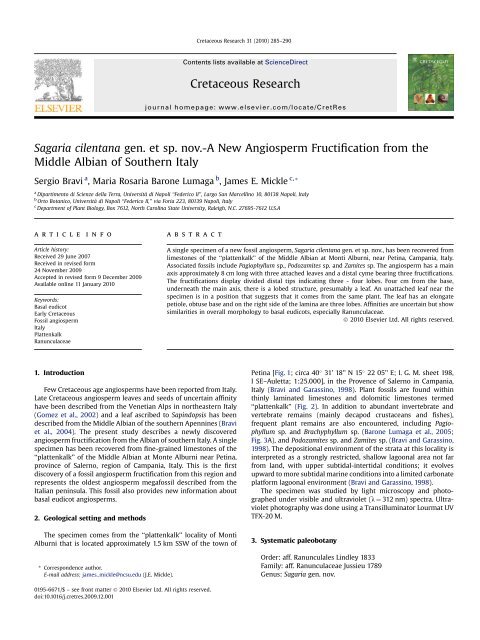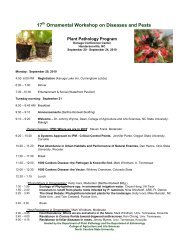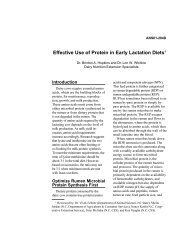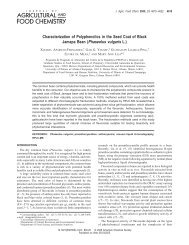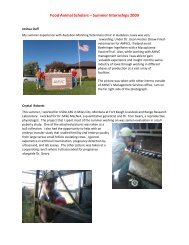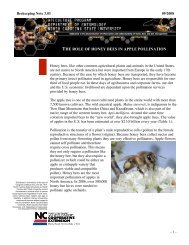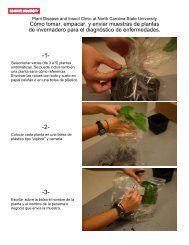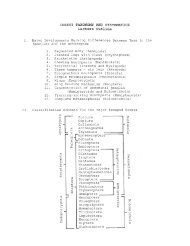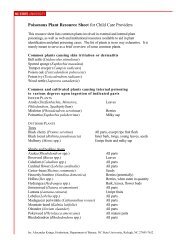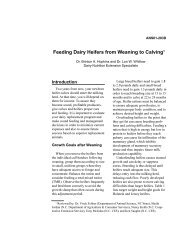Sagaria cilentana gen. et sp. nov.-A New Angiosperm Fructification ...
Sagaria cilentana gen. et sp. nov.-A New Angiosperm Fructification ...
Sagaria cilentana gen. et sp. nov.-A New Angiosperm Fructification ...
You also want an ePaper? Increase the reach of your titles
YUMPU automatically turns print PDFs into web optimized ePapers that Google loves.
<strong>Sagaria</strong> <strong>cilentana</strong> <strong>gen</strong>. <strong>et</strong> <strong>sp</strong>. <strong>nov</strong>.-A <strong>New</strong> Angio<strong>sp</strong>erm <strong>Fructification</strong> from the<br />
Middle Albian of Southern Italy<br />
Sergio Bravi a , Maria Rosaria Barone Lumaga b , James E. Mickle c, *<br />
a<br />
Dipartimento di Scienze della Terra, Università di Napoli ‘‘Federico II’’, Largo San Marcellino 10, 80138 Napoli, Italy<br />
b<br />
Orto Botanico, Università di Napoli ‘‘Federico II,’’ via Foria 223, 80139 Napoli, Italy<br />
c<br />
Department of Plant Biology, Box 7612, North Carolina State University, Raleigh, N.C. 27695-7612 U.S.A<br />
article info<br />
Article history:<br />
Received 29 June 2007<br />
Received in revised form<br />
24 November 2009<br />
Accepted in revised form 9 December 2009<br />
Available online 11 January 2010<br />
Keywords:<br />
Basal eudicot<br />
Early Cr<strong>et</strong>aceous<br />
Fossil angio<strong>sp</strong>erm<br />
Italy<br />
Plattenkalk<br />
Ranunculaceae<br />
1. Introduction<br />
abstract<br />
Few Cr<strong>et</strong>aceous age angio<strong>sp</strong>erms have been reported from Italy.<br />
Late Cr<strong>et</strong>aceous angio<strong>sp</strong>erm leaves and seeds of uncertain affinity<br />
have been described from the Ven<strong>et</strong>ian Alps in northeastern Italy<br />
(Gomez <strong>et</strong> al., 2002) and a leaf ascribed to Sapindopsis has been<br />
described from the Middle Albian of the southern Apennines (Bravi<br />
<strong>et</strong> al., 2004). The present study describes a newly discovered<br />
angio<strong>sp</strong>erm fructification from the Albian of southern Italy. A single<br />
<strong>sp</strong>ecimen has been recovered from fine-grained limestones of the<br />
‘‘plattenkalk’’ of the Middle Albian at Monte Alburni near P<strong>et</strong>ina,<br />
province of Salerno, region of Campania, Italy. This is the first<br />
discovery of a fossil angio<strong>sp</strong>erm fructification from this region and<br />
represents the oldest angio<strong>sp</strong>erm megafossil described from the<br />
Italian peninsula. This fossil also provides new information about<br />
basal eudicot angio<strong>sp</strong>erms.<br />
2. Geological s<strong>et</strong>ting and m<strong>et</strong>hods<br />
The <strong>sp</strong>ecimen comes from the ‘‘plattenkalk’’ locality of Monti<br />
Alburni that is located approximately 1.5 km SSW of the town of<br />
* Corre<strong>sp</strong>ondence author.<br />
E-mail address: james_mickle@ncsu.edu (J.E. Mickle).<br />
0195-6671/$ – see front matter Ó 2010 Elsevier Ltd. All rights reserved.<br />
doi:10.1016/j.cr<strong>et</strong>res.2009.12.001<br />
Cr<strong>et</strong>aceous Research 31 (2010) 285–290<br />
Contents lists available at ScienceDirect<br />
Cr<strong>et</strong>aceous Research<br />
journal homepage: www.elsevier.com/locate/Cr<strong>et</strong>Res<br />
A single <strong>sp</strong>ecimen of a new fossil angio<strong>sp</strong>erm, <strong>Sagaria</strong> <strong>cilentana</strong> <strong>gen</strong>. <strong>et</strong> <strong>sp</strong>. <strong>nov</strong>., has been recovered from<br />
limestones of the ‘‘plattenkalk’’ of the Middle Albian at Monti Alburni, near P<strong>et</strong>ina, Campania, Italy.<br />
Associated fossils include Pagiophyllum <strong>sp</strong>., Podozamites <strong>sp</strong>. and Zamites <strong>sp</strong>. The angio<strong>sp</strong>erm has a main<br />
axis approximately 8 cm long with three attached leaves and a distal cyme bearing three fructifications.<br />
The fructifications di<strong>sp</strong>lay divided distal tips indicating three - four lobes. Four cm from the base,<br />
underneath the main axis, there is a lobed structure, presumably a leaf. An unattached leaf near the<br />
<strong>sp</strong>ecimen is in a position that suggests that it comes from the same plant. The leaf has an elongate<br />
p<strong>et</strong>iole, obtuse base and on the right side of the lamina are three lobes. Affinities are uncertain but show<br />
similarities in overall morphology to basal eudicots, e<strong>sp</strong>ecially Ranunculaceae.<br />
Ó 2010 Elsevier Ltd. All rights reserved.<br />
P<strong>et</strong>ina [Fig. 1; circa 40 31’ 18’’ N 15 22 05’’ E; I. G. M. she<strong>et</strong> 198,<br />
I SE–Aul<strong>et</strong>ta; 1:25.000], in the Provence of Salerno in Campania,<br />
Italy (Bravi and Garassino, 1998). Plant fossils are found within<br />
thinly laminated limestones and dolomitic limestones termed<br />
‘‘plattenkalk’’ (Fig. 2). In addition to abundant invertebrate and<br />
vertebrate remains (mainly decapod crustaceans and fishes),<br />
frequent plant remains are also encountered, including Pagiophyllum<br />
<strong>sp</strong>. and Brachyphyllum <strong>sp</strong>. (Barone Lumaga <strong>et</strong> al., 2005;<br />
Fig. 3A), and Podozamites <strong>sp</strong>. and Zamites <strong>sp</strong>. (Bravi and Garassino,<br />
1998). The depositional environment of the strata at this locality is<br />
interpr<strong>et</strong>ed as a strongly restricted, shallow lagoonal area not far<br />
from land, with upper subtidal-intertidal conditions; it evolves<br />
upward to more subtidal marine conditions into a limited carbonate<br />
platform lagoonal environment (Bravi and Garassino, 1998).<br />
The <strong>sp</strong>ecimen was studied by light microscopy and photographed<br />
under visible and ultraviol<strong>et</strong> (l ¼ 312 nm) <strong>sp</strong>ectra. Ultraviol<strong>et</strong><br />
photography was done using a Transilluminator Lourmat UV<br />
TFX-20 M.<br />
3. Systematic paleobotany<br />
Order: aff. Ranunculales Lindley 1833<br />
Family: aff. Ranunculaceae Jussieu 1789<br />
Genus: <strong>Sagaria</strong> <strong>gen</strong>. <strong>nov</strong>.
286<br />
Derivation of Name: <strong>Sagaria</strong> is named in honor of the collector of<br />
the <strong>sp</strong>ecimen; Giovanni <strong>Sagaria</strong>.<br />
Type <strong>sp</strong>ecies: <strong>Sagaria</strong> <strong>cilentana</strong> <strong>sp</strong>. <strong>nov</strong>.<br />
Generic Diagnosis. Angio<strong>sp</strong>erm, axis with leaves and fruits.<br />
Leaves lobate, p<strong>et</strong>iolate. Distal tips of foliar lobes mucronate.<br />
Inflorescence cymose. Fruits borne by an elongate peduncle, on an<br />
expanded cup-shaped recepticle, up to 1.1 cm long, and 0.6 cm<br />
wide and composed of at least three follicles with a maximum<br />
width of 3 mm and partially fused in their basal three-quarters.<br />
Distal tips of the follicles mucronate.<br />
Derivation of <strong>sp</strong>ecific epith<strong>et</strong>. From the area, Cilento, in which the<br />
<strong>sp</strong>ecimen was found.<br />
Holotype. Specimen 301a housed at Museum of Paleobotany and<br />
Ethnobotany, at Orto Botanico University of Naples. (Fig. 3 A) [part]<br />
and <strong>sp</strong>ecimen 301b housed at the Paleontology Museum of<br />
Magliano V<strong>et</strong>ere (Cilento National Park), Provence of Salerno<br />
(Fig. 3B) [counterpart].<br />
Type locality. Monti Alburni locality located approximately<br />
1.5 km SSW of the town of P<strong>et</strong>ina [Fig. 1; circa 40 31’ 18’’ N 15 22<br />
05’’ E; I. G. M. she<strong>et</strong> 198, I SE–Aul<strong>et</strong>ta; 1:25.000], in the Provence of<br />
Salerno in Campania, Italy.<br />
Type Stratum. ‘‘Plattenkalk’’ at Monte Alburni (Bravi and Garassino,<br />
1998).<br />
Age. Middle Albian.<br />
Material. The <strong>sp</strong>ecies is represented by a single <strong>sp</strong>ecimen<br />
preserved as part and counterpart of a coalified compression.<br />
<strong>Sagaria</strong> <strong>cilentana</strong> <strong>sp</strong>. <strong>nov</strong>.<br />
Figs. 3–5<br />
Specific diagnosis. Characteristics as for the <strong>gen</strong>us.<br />
Description of <strong>sp</strong>ecimen<br />
The <strong>sp</strong>ecimen consists of a main axis with four attached leaves<br />
and a distal cyme bearing three fructifications. The <strong>sp</strong>ecimen is<br />
S. Bravi <strong>et</strong> al. / Cr<strong>et</strong>aceous Research 31 (2010) 285–290<br />
Fig. 1. Map showing the location of the plattenkalk of Monte Alburni in Campania.<br />
approximately 8 cm long, with the main axis about 1.75 mm wide<br />
and remaining at a relatively uniform width. In addition, there is<br />
a d<strong>et</strong>ached leaf that is clearly derived from the <strong>sp</strong>ecimen. The<br />
<strong>sp</strong>ecimen di<strong>sp</strong>lays five nodes (Fig. 3A,B). The di<strong>sp</strong>osition of the<br />
nodes indicates an alternate or helical arrangement of appendices.<br />
The two most proximal nodes show axes that are broken off but at<br />
their bases are approximately the same diam<strong>et</strong>er as the main axis of<br />
the <strong>sp</strong>ecimen (Fig. 3A).<br />
About 4 cm from the base of the <strong>sp</strong>ecimen and lying underneath<br />
the main axis there is a lobed structure, presumably a leaf (Fig. 3A,B,<br />
4G). It is quite folded and d<strong>et</strong>ails of the morphology are difficult to<br />
discern.<br />
Two small leaves are found in an axillary position approximately<br />
0.5 cm from the insertion of a lateral appendage (Figs. 3A,B, 4D,H).<br />
These leaves are probably in early stages of development. Both<br />
leaves are lobate and about 2 mm long. One leaf, more clearly<br />
visible, di<strong>sp</strong>lays three distinct lobes (Fig. 4H); at the apex of each<br />
lobe is a small, pointed tip (Fig. 4H arrow). Based on their position,<br />
these leaves could represent stipules or immature leaves of a small<br />
branch, however, the lack of such structures at other nodes indicates<br />
that these are leaves on a branch just beginning to develop.<br />
In proximity to the <strong>sp</strong>ecimen, part of a lobed leaf is visible on the<br />
matrix (Fig. 3A,B, 4D,E). The p<strong>et</strong>iole of this leaf is not in direct<br />
connection with the main axis (Figs. fig3A, 4D,H); however, from<br />
the position of the p<strong>et</strong>iole (Fig. 4H), and morphology of the leaf<br />
(Fig. 4D), it is highly probable that it comes from the same plant as<br />
the axis. The leaf has a p<strong>et</strong>iole that is 4 mm long and about 0.5 mm<br />
wide. The broken base of the p<strong>et</strong>iole matches the broken end of the<br />
adjacent appendage from the axis of the <strong>Sagaria</strong> <strong>sp</strong>ecimen<br />
(Fig. 4D,H). The leaf shows an obtuse base, and on the right side of<br />
the lamina three lobes with deep sinuses are visible (Fig. 4E). Lobes<br />
are about 2 mm deep and 1.5 mm wide (Fig. 4D,E). At the apex of<br />
each lobe is a small pointed tip (Fig. 4D,E arrow). Primary venation<br />
is faint but medial (Fig. 4D). It is not possible to discern secondary<br />
venation, but the position of the lobes and the mucronate tip<br />
suggest a median secondary vein at a perpendicular angle to the
primary veins. The form of the leaf and broken p<strong>et</strong>iole base strongly<br />
indicate that this leaf is from the <strong>Sagaria</strong> <strong>sp</strong>ecimen.<br />
At the distal end of the axis a dichasium subtended by a 5 mm<br />
long axillary bract bears three fructifications (Figs. 3A,B). One<br />
fructification is borne singly on what appears to be a continuation<br />
of the main axis (Fig. 3A), the other two are borne on a branching<br />
lateral axis, giving a cymose appearance to the <strong>sp</strong>ecimen (Fig. 3A,B).<br />
The lateral axis is subtended by a leaf (Fig. 4I arrow) whose<br />
attachment was visible most clearly under ultraviol<strong>et</strong> light. The leaf<br />
is folded proximally and the lamina is partially obscured by the<br />
lamina of the d<strong>et</strong>ached leaf (Figs. 3A, 4I).<br />
The first fructification is 1.1 cm long, and 0.6 cm wide (Figs. 3A,B,<br />
4A). This fructification is borne on a pedicel 1 cm long and 1 mm<br />
wide that supports one enlarged, cup-shaped receptacle (Fig. 4A).<br />
Fine striations are visible on the pedicel proximal to the receptacle<br />
(Fig. 5A, lower arrow). Three follicles are visible (Fig. 4A, 5A,B). The<br />
follicles have a maximum width of 3 mm and are fused at their<br />
basal three-quarters. The tips of the follicles are mucronate (Fig. 4A,<br />
5A,B). On the first fructification there is a single longitudinal line<br />
visible (Fig. 5A, upper arrow) on one of the lobes, e<strong>sp</strong>ecially on the<br />
counterpart (Fig. 5B, arrow). A similar line is also visible on the part,<br />
on another lobe (Fig. 5A, arrow). These lines appear to represent<br />
dehiscence slits. Because these putative dehiscence slits are seen<br />
only on part or counterpart suggests that they occur only on one<br />
S. Bravi <strong>et</strong> al. / Cr<strong>et</strong>aceous Research 31 (2010) 285–290 287<br />
Fig. 2. Geological section of the plattenkalk of Monte Alburni in Campania.<br />
face of the fruit wall. This further suggests that the fructification is<br />
composed of fused or partially fused follicles. At a distance of<br />
approximately 1.5 mm from the receptacle two linear structures<br />
appear in the illustrations (Fig. 4A) approximately 2.5 mm long that<br />
appear to be bract-like leaves. However, these structures are<br />
actually artifacts of the matrix fracture pattern from collection<br />
(Fig. 5A) and are not bracts.<br />
The other two fructifications are of similar size and show only<br />
the outer surfaces (Figs. 3A,B, 4B,C). The distal tips are not as<br />
distinct in the matrix as the first fructification, but clearly di<strong>sp</strong>lay<br />
three, possibly four lobes (Fig. 4B,C). They are borne on a branching<br />
axis (Fig. 3A,B) with the first of the two fructifications borne nearly<br />
sessile; the other is on a pedicel about 0.5 cm long. The fructifications<br />
are inserted on an expanded receptacle that is 2.0 mm long<br />
and expands to 2.3 mm in diam<strong>et</strong>er (Fig. 4F). One of the fructifications<br />
has basal markings that are suggestive of scars of other<br />
floral parts (Fig. 4F). There is no other evidence of a calyx or corolla<br />
present on the fossil.<br />
4. Discussion<br />
Because it is incompl<strong>et</strong>ely preserved, taxonomic placement of<br />
this fossil is somewhat problematic. One possibility is that it is<br />
a gn<strong>et</strong>ophyte. However, the reproductive structures do not appear
288<br />
Fig. 3. <strong>Sagaria</strong> <strong>cilentana</strong> part and counterpart. A, entire <strong>sp</strong>ecimen; arrows indicate<br />
positions of nodes. Note Pagiophyllum <strong>sp</strong>. on the right; scale bar ¼ 1 cm. B, counterpart<br />
to A; scale bar ¼ 1 cm.<br />
to be paired, as occurs in Gn<strong>et</strong>ales (Foster and Gifford, 1989; Krassilov<br />
and Bugdaeva, 2000) and the leaves are unlike any known<br />
gn<strong>et</strong>ophyte, living or fossil, in phyllotaxy or morphology (Foster<br />
and Gifford, 1989; Taylor <strong>et</strong> al., 2009). The fossil does not closely<br />
resemble any other group with the exception of the dicotyledonous<br />
angio<strong>sp</strong>erms.<br />
The overall form of the fruit, the fruit’s position with re<strong>sp</strong>ect<br />
to the receptacle, and possible scars of subtending organs indicate<br />
that <strong>Sagaria</strong> possessed a superior ovary. It is impossible to<br />
ascertain if the flower was perfect or imperfect, or if sepals,<br />
p<strong>et</strong>als or either were present in the living plant. The degree of<br />
fusion of the fruit of <strong>Sagaria</strong> is also difficult to interpr<strong>et</strong>, e<strong>sp</strong>ecially<br />
in light of the incompl<strong>et</strong>e preservation of two of the three<br />
<strong>sp</strong>ecimens preserved. The best preserved <strong>sp</strong>ecimen shows<br />
a degree of fusion reflecting about G of the distance from the<br />
base to distal tip. This may represent the actual developmental<br />
degree of fusion or may represent a stage in which all of the<br />
follicles were fused and as dehiscence occurred, the follicles<br />
separated from each other as occurs in a number of <strong>sp</strong>ecies (e. g.,<br />
Anderberg, 2001: delpsta1.htm).<br />
In the absence of cuticle, sepals, p<strong>et</strong>als, stamens, clear scars of<br />
these floral parts or associated pollen, affinities of this fossil are<br />
problematic to ascertain. The <strong>gen</strong>eral features of <strong>Sagaria</strong>, including<br />
a capsular fruit composed of at least three follicles and fruits borne<br />
in a cyme are most consistent with those of ‘‘basal’’ eudicots as<br />
outlined by APG (1998, 2003). Among the basal eudicots, <strong>sp</strong>ecific<br />
affinities of <strong>Sagaria</strong> are not entirely clear, but shape, di<strong>sp</strong>osition,<br />
fusion and apparent mode of dehiscence of the fruit, apparent<br />
herbaceous habit, and lobed leaves are most similar to those seen in<br />
Ranunculales, e<strong>sp</strong>ecially Ranunculaceae (Cronquist, 1981) such as<br />
Delphinium (Moraldo <strong>et</strong> al., 1981; Anderberg, 2001). Certainly,<br />
S. Bravi <strong>et</strong> al. / Cr<strong>et</strong>aceous Research 31 (2010) 285–290<br />
fused fruits occur in other families such as the Trochodendraceae<br />
(Cronquist, 1981) but the overall form of the fructification is most<br />
similar to Ranunculaceae (Cronquist, 1981).<br />
A number of fossil Ranunuculaceae are known (see Pigg and<br />
DeVore, 2005). Among these are forms known from the Early<br />
Cr<strong>et</strong>aceous, including Teixeiraea lusitanica (von Balthazar <strong>et</strong> al.,<br />
2005), a fossil similar to Thalictrum (Friis <strong>et</strong> al., 1994), Hyrcantha<br />
karatscheensis (Krassilov <strong>et</strong> al., 1983), H. decussatus (Dilcher <strong>et</strong> al.,<br />
2007), Achaenocarpites capitellatus (Krassilov and Volyn<strong>et</strong>s, 2008)<br />
and Ternicarpites floribundus (Krassilov and Volyn<strong>et</strong>s, 2008).<br />
Teixeiraea lusitanica consists of a charcoalified fossil flower bud<br />
from the late Aptian or early Albian of Portugal that has been<br />
attributed to Ranunculales, possibly Ranunculaceae (von Balthazar<br />
<strong>et</strong> al., 2005). Teixeiraea has no veg<strong>et</strong>ative features preserved, thus<br />
few features of this <strong>sp</strong>ecies are preserved in common for comparison<br />
with <strong>Sagaria</strong>. Teixeiraea is unisexually staminate, while <strong>Sagaria</strong><br />
is bisexual or unisexually carpellate. Additional <strong>sp</strong>ecimens of each<br />
<strong>sp</strong>ecies may permit more direct comparison.<br />
Early Cr<strong>et</strong>aceous fruits from the Famalicão and Vale di Agua<br />
localities in Portugal similar to Thalictrum (Ranunculaceae) are<br />
reported by Friis <strong>et</strong> al. (1994). These fruits clearly differ from<br />
<strong>Sagaria</strong>. The fruits reported by Friis <strong>et</strong> al. (1994) are about one-third<br />
the size of <strong>Sagaria</strong> and have marked longitudinal ribs in contrast to<br />
the lack of ribs in <strong>Sagaria</strong>.<br />
Hyrcantha karatscheensis is known from the Middle Albian of<br />
Kazakhstan (Krassilov <strong>et</strong> al., 1983). The gynoecium of H. karatscheensis<br />
possesses three or five free carpels and a persistent<br />
calyx is present. Leaves are pinnately compound (Krassilov <strong>et</strong> al.,<br />
1983). <strong>Sagaria</strong> differs from H. karatscheensis in that <strong>Sagaria</strong> has<br />
fused carpels, lacks a persistent calyx, and di<strong>sp</strong>lays simple, lobate<br />
leaves.<br />
Hyrcantha decussatus is known from the Barremian or Aptian of<br />
the Yixian Formation of China (Leng and Friis, 2003; Dilcher <strong>et</strong> al.,<br />
2007) and shows 3–4 carpels that are basally fused for about onehalf<br />
of their length, but as in <strong>Sagaria</strong>, it is difficult to ascertain if the<br />
degree of fusion is due to development or dehiscence. The size of<br />
the carpels are similar, 1.25 cm long in H. decussatus and 1.1 cm in<br />
<strong>Sagaria</strong>, but the arrangement of fruits is decussate in H. decussatus<br />
(Leng and Friis, 2003; Dilcher <strong>et</strong> al., 2007) whereas they do not<br />
appear to be so in <strong>Sagaria</strong>. Further, an ochrea is reported at the<br />
nodes and base of the fruits in H. decussatus (Dilcher <strong>et</strong> al., 2007),<br />
a characteristic not present in <strong>Sagaria</strong>.<br />
Achaenocarpites capitellatus and Ternicarpites floribundus were<br />
described from the Middle Albian of the Primorye Region of Russian<br />
Far East by Krassilov and Volyn<strong>et</strong>s (2008). Both are referred to<br />
Ranunculaceae, and are both known from whole or nearly whole<br />
plants that show a rhizomatous habit. Achaenocarpites is characterized<br />
by fruiting heads composed of 16 radially <strong>sp</strong>reading<br />
achenes while <strong>Sagaria</strong> differs in fruit type and number of fruits per<br />
fruiting structure. A small leaf associated with Achaenocarpites is<br />
trilobed (Krassilov and Volyn<strong>et</strong>s, 2008) and similar in appearance<br />
to the small leaf attached to the axis of <strong>Sagaria</strong>. Ternicarpites is<br />
known from several branching axes with terminal fruits. The fruits<br />
are ternate follicles 6–8 mm long, showing a longitudinal keel of<br />
two parallel ridges and free to the base (Krassilov and Volyn<strong>et</strong>s,<br />
2008). Fruits of <strong>Sagaria</strong> are larger, about 11 mm long, partially<br />
fused, and do not show a keel. Leaves associated with Ternicarpites<br />
are more deeply lobed than those of <strong>Sagaria</strong>, with the leaves of<br />
Ternicarpites appearing nearly pinnate (Krassilov and Volyn<strong>et</strong>s,<br />
2008) while the leaves of <strong>Sagaria</strong> are more laminar.<br />
In addition to leaves discussed above, a few angio<strong>sp</strong>erm leaves<br />
from the Early Cr<strong>et</strong>aceous also di<strong>sp</strong>lay a deeply lobed morphology<br />
as seen in <strong>Sagaria</strong>. One of these is Vitiphyllum Fontaine. (1889; Doyle<br />
and Hickey, 1976) from the Lower Cr<strong>et</strong>aceous of eastern North<br />
America. Both the leaves associated with <strong>Sagaria</strong> and Vitiphyllum
are simple, lobed leaves but Vitiphyllum shows a greater degree and<br />
complexity of lobing than seen in those associated with <strong>Sagaria</strong>;<br />
there is probably little affinity b<strong>et</strong>ween these <strong>gen</strong>era. Another is the<br />
<strong>gen</strong>us Araripia Mohr and Ecklund (2003). <strong>Sagaria</strong> differs from<br />
Araripia in that <strong>Sagaria</strong> leaves are more highly lobed and the<br />
venation in <strong>Sagaria</strong> is inferred to be at a more perpendicular angle.<br />
The base of the leaf attributed to <strong>Sagaria</strong> is similar to that seen in<br />
S. Bravi <strong>et</strong> al. / Cr<strong>et</strong>aceous Research 31 (2010) 285–290 289<br />
Fig. 4. Fruits and leaves of <strong>Sagaria</strong> <strong>cilentana</strong>. A, single fruit; scale bar ¼ 1 mm. B, first fruit of a pair of fruits on branch; scale bar ¼ 1 mm. C, second fruit of paired fruits on branch;<br />
scale bar ¼ 1 mm. D, d<strong>et</strong>ached lobed leaf showing probable point of attachment and axillary branch with two small attached leaves; scale bar ¼ 1 mm. E, lobes of d<strong>et</strong>ached leaf in D.<br />
Arrow indicates the small mucronate tip of leaf lobe; scale bar ¼ 1 mm. F, base of fruit in B, showing possible scars of floral parts; scale bar ¼ 1 mm. G, stem with lamina of leaf<br />
compressed underneath; scale bar ¼ 1 mm. H, base of p<strong>et</strong>iole with axillary branch bearing small lobed leaves. Arrow indicates small mucronate tip of leaf lobe; scale bar ¼ 1 mm. I,<br />
base of cyme with subtending p<strong>et</strong>iole (arrow); scale bar ¼ 1 mm.<br />
Ranunculus. Araripia is attributed to Lauraceae (Mohr and Ecklund,<br />
2003).<br />
<strong>Sagaria</strong> adds to the growing number of basal eudicots known from<br />
the Early Cr<strong>et</strong>aceous flora. While the exact morphology and affinities<br />
of <strong>Sagaria</strong> are uncertain, its characteristics place it most closely with<br />
the Ranunculales. The great diversity di<strong>sp</strong>layed by <strong>Sagaria</strong>, Teixeiraea<br />
(von Balthazar <strong>et</strong> al., 2005), Thalictrum-like fossil (Friis <strong>et</strong> al., 1994),
290<br />
Fig. 5. Fruit of <strong>Sagaria</strong> <strong>cilentana</strong>. A, fruit in Fig. 4a showing the presumed line of dehiscence (upper arrow) and fine longitudinal striations on pedicel (lower arrow); scale<br />
bar ¼ 1 mm. B, counterpart of A, showing the presumed line of dehiscence (arrow); scale bar ¼ 1 mm.<br />
Hyrcantha (Krassilov <strong>et</strong> al., 1983; Leng and Friis, 2003; Dilcher <strong>et</strong> al.,<br />
2007), Achaenocarpites, and Ternicarpites (Krassilov and Volyn<strong>et</strong>s,<br />
2008) suggests that early radiation of ranunculoid eudicots was well<br />
underway during Early Cr<strong>et</strong>aceous time.<br />
Acknowledgement<br />
The authors thank Valerie Knowlton for her assistance in<br />
preparing the figures. We also thank Drs. P<strong>et</strong>er Endress, James<br />
Doyle, David Dilcher and the reviewers for their constructive<br />
comments.<br />
References<br />
Anderberg, A., 2001. Linnean herbarium (S-LINN). http://linnaeus.nrm.se/botany/<br />
fbo/d/delph/delpsta.html.en R<strong>et</strong>rieved May 12, 2006, from.<br />
Angio<strong>sp</strong>erm Phylo<strong>gen</strong>y Group [APG], 1998. An ordinal classification of the families<br />
of flowering plants. Annals of the Missouri Botanical Garden 85, 531–553.<br />
Angio<strong>sp</strong>erm Phylo<strong>gen</strong>y Group [APG], 2003. An update of the Angio<strong>sp</strong>erm Phylo<strong>gen</strong>y<br />
Group classification for the orders and families of flowering plants: APG II.<br />
Botanical Journal of the Linnean Soci<strong>et</strong>y 141, 399–436.<br />
von Balthazar, M., Pedersen, K.R., Friis, E.M., 2005. Teixeiraea lusitanica, a new fossil<br />
flower from the Early Cr<strong>et</strong>aceous of Portugal with affinities to Ranunculales.<br />
Plant Systematics and Evolution 255, 55–75.<br />
Barone Lumaga, M.R., Bravi, S., Mickle, J.E., Bartiromo, A., 2005. Osservazioni paleontologiche<br />
sulle macroflore fossili del Cr<strong>et</strong>acico dell’Appennino meridionale.<br />
Informatore Botanico Italiano 37 (1, Parte B), 892–893.<br />
Bravi, S., Garassino, A., 1998. ‘‘Plattenkalk’’ of the Lower Cr<strong>et</strong>aceous (Albian) of<br />
P<strong>et</strong>ina, in the Alburni Mounts (Campania, S Italy), and its decapod crustacean<br />
assemblage. In: Atti della Soci<strong>et</strong>à Italiana di Scienze Naturali e del Museo Civico<br />
di Storia Naturale di Milano 138/1997 (I-II), pp. 89–118.<br />
Bravi, S., Civile, D., Martino, C., Barone Lumaga, M.R., Nardi, G., 2004. Geological and<br />
paleontological observations on a fossil plant horizon in the Cenomanian of<br />
Mount Chianello (Southern Apennines). Boll<strong>et</strong>tino della Soci<strong>et</strong>à Geologica<br />
Italiana 123, 19–38.<br />
S. Bravi <strong>et</strong> al. / Cr<strong>et</strong>aceous Research 31 (2010) 285–290<br />
Cronquist, A., 1981. An Integrated System of Classification of Flowering Plants.<br />
Columbia University Press, <strong>New</strong> York.<br />
Dilcher, D.L., Sun, G., Ji, Q., Li, H., 2007. An early infructescence Hyrcantha decussata<br />
(comb. <strong>nov</strong>.) from the Yixian Formation of northeastern China. Proceedings of<br />
the National Academy of Sciences of the United States of America 104,<br />
9370–9374.<br />
Doyle, J.A., Hickey, L.J., 1976. Pollen and leaves from the mid-Cr<strong>et</strong>aceous Potomac<br />
Group and their bearing on early angio<strong>sp</strong>erm evolution. In: Beck, C.B. (Ed.),<br />
Origin and Early Evolution of Angio<strong>sp</strong>erms. Columbia University Press, <strong>New</strong><br />
York, pp. 139–206.<br />
Fontaine, W.M., 1889. The Potomac or Younger Mesozoic Flora. United States<br />
Geological Survey Monograph 15, Washington, D. C.<br />
Friis, E.M., Pedersen, K.R., Crane, P.R., 1994. Angio<strong>sp</strong>erm floral structures from the<br />
Early Cr<strong>et</strong>aceous of Portugal. Plant Systematics and Evolution [Supplement] 8,<br />
31–49.<br />
Foster, A.S., Gifford, E.M., 1989. Morphology and Evolution of Vascular Plants, third<br />
ed. W.H. Freeman and Co, <strong>New</strong> York.<br />
Gomez, B., Thévenard, F., Fantin, M., Giusberti, L., 2002. Late Cr<strong>et</strong>aceous plants from<br />
the Bonarelli Level of theVen<strong>et</strong>ian Alps, northeastern Italy. Cr<strong>et</strong>aceous Research<br />
23, 671–685.<br />
Krassilov, V.A., Shilin, P.V., Vachrameev, V.A., 1983. Cr<strong>et</strong>aceous flowers from<br />
Kazakhstan. Review of Palaeobotany and Palynology 40, 91–113.<br />
Krassilov, V.A., Bugdaeva, E.V., 2000. Gn<strong>et</strong>ophyte assemblage from the Early<br />
Cr<strong>et</strong>aceous of Transbaikalia. Palaeontographica 208B, 139–151.<br />
Krassilov, V.A., Volyn<strong>et</strong>s, Y., 2008. Weedy Albian angio<strong>sp</strong>erms. Acta Palaeobotanica<br />
48, 151–169.<br />
Leng, Q., Friis, E.M., 2003. Sinocarpus decussatus <strong>gen</strong>. <strong>et</strong> <strong>sp</strong>. <strong>nov</strong>., a new angio<strong>sp</strong>erm<br />
with basally syncarpous fruits from the Yixian Formation of northeast China.<br />
Plant Systematics and Evolution 241, 77–88.<br />
Mohr, B.A.R., Ecklund, H., 2003. Araripia florifera a magnoliid angio<strong>sp</strong>erm from the<br />
Lower Cr<strong>et</strong>aceous Crato Formation (Brazil). Review of Palaeobotany and Palynology<br />
126, 279–292.<br />
Moraldo, B., Nardi, E., La Valva, V., 1981. Aquilegia champagnatii <strong>sp</strong>. <strong>nov</strong>. (Ranunculaceae)<br />
nell’Appennino campano. Webbia 35, 83–86.<br />
Pigg, K.B., DeVore, M.L., 2005. Paleoactaea <strong>gen</strong>. <strong>nov</strong>. (Ranunculaceae) fruits from the<br />
Paleo<strong>gen</strong>e of North Dakota and the London Clay. American Journal of Botany 92,<br />
1650–1659.<br />
Taylor, T.N., Taylor, E.L., Krings, M., 2009. Paleobotany. The Biology and Evolution of<br />
Fossil Plants, second ed. Academic Press, Oxford.


